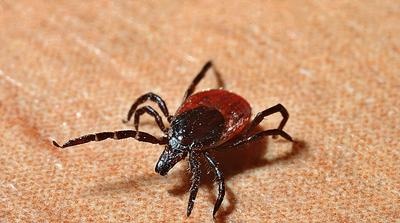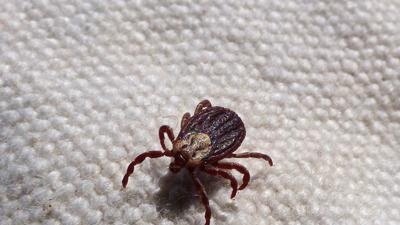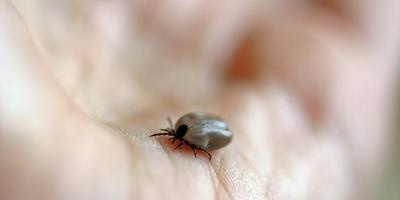|
 Many forests are natural foci of a serious disease - tick-borne encephalitis. It is mainly distributed in the taiga of Siberia and the Far East, but it also occurs in some forest regions of the western part of Russia. Many forests are natural foci of a serious disease - tick-borne encephalitis. It is mainly distributed in the taiga of Siberia and the Far East, but it also occurs in some forest regions of the western part of Russia.
The causative agent of tick-borne encephalitis is a special virus, first discovered by Soviet scientists in 1937. The virus lives and multiplies in the body of forest ticks and is transmitted from generation to generation. The main vectors of the virus are ixodid ticks. They are also its main keepers (reservoir) in nature. Ixodid ticks acquire the virus either by inheritance or by sucking the blood of infected birds or wild animals.
Favorite places where ticks stay: roadsides and paths in mixed forests, shores of forest streams and lakes overgrown with tall lush grass, where animals come to watering places, forest cuttings where rodents like to settle.
Ticks attack, and a person. After awakening from the winter numbness, hungry ticks are especially active from mid-April to mid-July. Later, the number of hungry ticks decreases, and those that have sucked blood are no longer dangerous, since they do not attack either animals or humans more than once a season.
 Ticks are very aggressive from 8 am to 11 am and from 5 pm to 20 pm and in cloudy weather all day long. Ticks lie in wait for their prey, climbing over the stems of grasses, over bushes to a height of 30 centimeters and above. They extend the front pair of legs, on which their well-developed olfactory organs are located. With their help, ticks catch the approach of an animal or a person 3-5 meters away and take a pose that is convenient for an attack. The mite enters under clothing and looks for a suitable place to suck. Ticks are very aggressive from 8 am to 11 am and from 5 pm to 20 pm and in cloudy weather all day long. Ticks lie in wait for their prey, climbing over the stems of grasses, over bushes to a height of 30 centimeters and above. They extend the front pair of legs, on which their well-developed olfactory organs are located. With their help, ticks catch the approach of an animal or a person 3-5 meters away and take a pose that is convenient for an attack. The mite enters under clothing and looks for a suitable place to suck.
A person usually does not feel when a tick sticks to the skin, since the secret of his salivary glands contains substances that not only prevent blood clotting, but also pain relievers. Together with the saliva of the tick, the virus also enters the human bloodstream, and its entry occurs during the entire time of bloodsucking - up to 6-8 days or even more. This means that the later a person detects and removes an infected tick that has stuck to his body, the greater the dose of viruses will enter the body, which, in turn, can affect the severity of the disease.
One to two weeks after infection, sometimes a little earlier or later, signs of tick-borne encephalitis appear; severe headache, some confusion, delirium and convulsions, high body temperature, vomiting. The consequences of tick-borne encephalitis can be paresis and paralysis.
The local sanitary service strictly monitors the prevalence of encephalitis. Those who have to live and work in an epidemically unfavorable forest (geologists, surveyors, construction workers or lumberjacks) are pre-vaccinated to ensure persistent immunity to encephalitis. At the Institute of Poliomyelitis and Viral Encephalitis of the Academy of Medical Sciences, work continues to create an even more effective vaccine against tick-borne encephalitis.
But those who go to the forest for a short walk do not need vaccination. Closed clothing that fits tightly to the body reliably protects against ticks: trousers tucked into boots or socks, with a tightly tightened belt and a shirt tucked into them with a closed collar, with long sleeves ending in cuffs or elastic bands that fit tightly to the arm. Increases the protective properties of clothing by spraying it with dimethyl phthalate, repudin, "Taiga" or any other repellent.
After 2-3 hours of staying in the forest and after leaving the forest, it is imperative to inspect your clothes and body, especially carefully those places where ticks are most often sucked in - neck, ears, armpits, chest, waist, groin folds.In clothes, you should carefully check all the seams, folds, where ticks can hide.
 If a dog was taken for a walk, when leaving the forest with it, carefully examine it for ticks on the fur, otherwise it may bring them into the house. It is also necessary to examine the bouquet of forest flowers, herbs, because with them you can also bring ticks into the house. Such cases are known. If a dog was taken for a walk, when leaving the forest with it, carefully examine it for ticks on the fur, otherwise it may bring them into the house. It is also necessary to examine the bouquet of forest flowers, herbs, because with them you can also bring ticks into the house. Such cases are known.
If, upon examination, a sucked mite is found on the skin, it must be immediately very carefully removed. So that the proboscis does not remain in the skin and does not cause suppuration, the tick is lubricated with any fat or petroleum jelly, which will clog the airways in the tick's body, and it will easily fall off.
When removing a tick, the head sometimes comes off, which, after wiping the skin with a damp handkerchief, is visible at the place of suction in the form of a black dot. It must be removed with a calcined needle. It is recommended to lubricate the suction site with iodine, and burn the extracted tick. But if possible, you should try to deliver the tick in a glass sealed container to the sanitary and epidemiological station or to the doctor.
In order to take preventive measures on time, you must immediately contact a medical institution. This is especially important in areas where tick-borne encephalitis is common. By the way, in these areas you cannot drink raw goat milk, since when infected ticks attack goats, the virus enters their body and, multiplying, is excreted with milk. There are cases, albeit rare, of tick-borne encephalitis disease when raw cow's milk is consumed.
A. N. Shapoval
Read now
All recipes
|
 Many forests are natural foci of a serious disease - tick-borne encephalitis. It is mainly distributed in the taiga of Siberia and the Far East, but it also occurs in some forest regions of the western part of Russia.
Many forests are natural foci of a serious disease - tick-borne encephalitis. It is mainly distributed in the taiga of Siberia and the Far East, but it also occurs in some forest regions of the western part of Russia. Ticks are very aggressive from 8 am to 11 am and from 5 pm to 20 pm and in cloudy weather all day long. Ticks lie in wait for their prey, climbing over the stems of grasses, over bushes to a height of 30 centimeters and above. They extend the front pair of legs, on which their well-developed olfactory organs are located. With their help, ticks catch the approach of an animal or a person 3-5 meters away and take a pose that is convenient for an attack. The mite enters under clothing and looks for a suitable place to suck.
Ticks are very aggressive from 8 am to 11 am and from 5 pm to 20 pm and in cloudy weather all day long. Ticks lie in wait for their prey, climbing over the stems of grasses, over bushes to a height of 30 centimeters and above. They extend the front pair of legs, on which their well-developed olfactory organs are located. With their help, ticks catch the approach of an animal or a person 3-5 meters away and take a pose that is convenient for an attack. The mite enters under clothing and looks for a suitable place to suck. If a dog was taken for a walk, when leaving the forest with it, carefully examine it for ticks on the fur, otherwise it may bring them into the house. It is also necessary to examine the bouquet of forest flowers, herbs, because with them you can also bring ticks into the house. Such cases are known.
If a dog was taken for a walk, when leaving the forest with it, carefully examine it for ticks on the fur, otherwise it may bring them into the house. It is also necessary to examine the bouquet of forest flowers, herbs, because with them you can also bring ticks into the house. Such cases are known.



